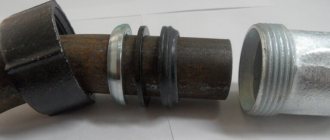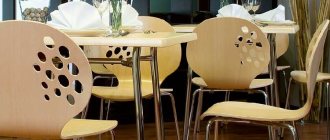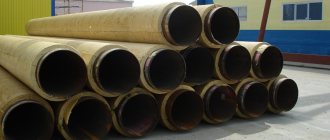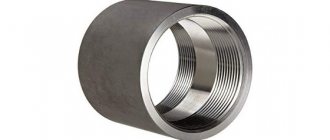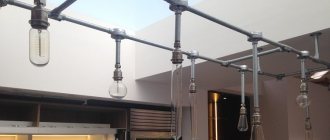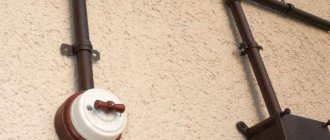The excellent physical characteristics of profile pipes make them a universal material for the manufacture of various structures. With a relatively low weight, they have high values of resistance to bending and compression, and excellently withstand constant and multidirectional variable forces.
Profile pipes are much easier to weld and cut than traditional round pipes, and they also look more attractive. From such pipes you can make a comfortable and reliable bench, spending very little time and effort on the work.
Do-it-yourself benches from a profile pipe
Description and dimensions
The simplest metal bench for a summer house consists of two supports and a seat. For greater comfort of vacationers, a backrest is provided.
Thematic material:
- DIY wooden benches
- DIY furniture for the garden
Benches made of iron without the use of other materials (wood, plastic, etc.) are classified as anti-vandal.
However, it is irrational to install such furniture in the courtyard of a house. After all, metal has tens of times greater thermal conductivity; sitting on it is uncomfortable and even harmful to health. Therefore, it is better to build a country bench according to the formula: metal frame + wooden seat with backrest.
Diagram of a bench made of a profile pipe with a cross-section of 25x30 mm and a wooden beam 60x30 mm.
The dimensions of the bench are selected individually. But there are several rules that it is advisable to take into account:
- The length of the bench is determined at the rate of 0.6 m per person.
- Width – minimum 30 cm.
- Back height – from 30 cm.
- The angle between the seat and backrest is from 105° to 120°.
- The height of the bench is determined by the length of the tibia (to the popliteal fossa). Usually it is 38-45 cm.
If the bench is above 45 cm, then the legs hang down; when below 30 cm, the knees are bent at an acute angle, which impedes blood circulation and manifests itself in the form of an uncomfortable feeling of numb legs. Another nuance that requires attention when designing is the relative position of the backrest and seat. If the angle between them approaches a right angle, then you will have to sit as if you had swallowed a crowbar. From a physiological point of view, this is useful for the spine... But it is inconvenient.
Assembly instructions
Select bench legs and buy a piece of wood for the seat. A quick search online will help you find a place near you that sells the seat! When it comes to bench supports, opt for thick steel legs. You can find a store and order legs with the exact width and height! Attach the legs to the wooden board using furniture screws. To do this, you will have to drill holes in the metal legs and in the board.
After the bench is ready, the wood can be stained with a color stain (there is a wide choice available). The metal legs should be coated with black paint.
Note!
Blinds for gazebos: wooden, metal, bamboo. Instructions for installing blinds yourself
Adding a terrace to your house with your own hands: step-by-step instructions on how to easily and quickly add a veranda or terrace (100 design photos)
How to attach a veranda to your house with your own hands - step-by-step instructions from A to Z + photos of new designs
Instructions if you decide to make a bench without buying ready-made legs:
- It is better to take square pipes and cut them according to the drawings or personal preferences. You should consider who the bench is being created for (for a family with children, only for adults, for tall people, for very overweight relatives).
- Solder the pipes: two large squares serve as bench legs and armrests. A long pipe is soldered between them, onto which a wooden board for sitting will be attached.
- Solder the back of a square pipe (in the shape of a rectangle, plank or other shape) to the squares.
- Screw the board to the seat and cover it with colored stain.
- Paint the metal parts of the bench with black paint. All!
Options for arrangement of wooden parts
There are two ways to place bars - along and across. There is much less work with the longitudinal one, but the transverse one allows you to make a more convenient, homey bench.
Arrangement of boards across – 1, along – 2
Considering that the frame is the same in both cases, additional work is required only for drilling holes and manufacturing wooden elements.
In case of damage, it is much easier to change the transversely located lamellas, and such repairs are cheaper.
Bench protective covering
Wood and metal are processed separately. It is better to use a primer for the frame. Ideally, red lead will be used, which will protect the metal frame from corrosion for decades. Especially when you consider that at the dacha such garden furniture is under the snow for six months.
The wood can simply be painted. But if you first dry it, let it dry for a couple of days, then apply varnish in two layers, then such a coating is guaranteed to protect the wood from environmental influences.
Two benches with a table on a rolled metal frame
In any case, color compatibility and design ideas are important. For example, if the frame is covered with Kuzbasslak, then it is better to varnish the wooden parts, this will emphasize the natural texture of the material.
To make the protection of the bars effective, the treatment is carried out before fixing to the frame.
Decor features
The beauty of garden benches is that they do not need special decor at all. Well-treated wood, varnished, will organically fit into the natural landscape. But you don’t have to make do with an ordinary bench if you have the skill and the opportunity to decorate it with decorative elements.
A successful design will make a comfortable attribute for relaxation a real decoration of the garden, which will stylishly fit into the landscape and significantly transform it.
It could be:
- wood carving - patterns or openwork elements;
- painting with acrylic paints;
- decoupage
You can combine several finishing options, for example, apply decoupage designs and add a carved back. A simple and interesting solution would be to use several bars to create a backrest. The design will be laconic but stylish. In the same way, you can assemble a seat using several narrow boards, fastened with ties or nailed end to end. The alternation of light and dark wood will look interesting.
Benches with openwork carved inserts and overlay ornaments will elegantly complement the design of the garden courtyard and family recreation area in a natural landscape style.
Raw materials for frame
Depending on the type of metal base, the following types of garden benches are distinguished:
- forged;
- from a professional pipe;
- from the corners;
- from scrap metal.
Materials for manufacturing: profile 25x25 - 6 meters, timber 60x20 and 80x40, 5 meters each.
Forged benches
They belong to the category of luxury furniture, which adds solidity to the garden plot and increases the status of the owner. Forged items belong to two groups:
- machine (cold) forging;
- artistic (manual).
In the first case, the finished product is welded from elements subjected to machine processing (casting, stamping, rolling). To create a garden bench from such components, you need a drawing on which all the parts and their locations are marked. The elements are fixed by welding. Then the seams are cleaned, sanded, and the finished product is primed. Such a bench for a summer house will cost 5 times less than one made by artistic forging.
But it’s impossible to make a hand-forged shop without special skills. The sidewalls can be purchased separately and the seat can be fixed to them. On the one hand, this is a good solution, because you can independently adjust the length of the bench, but on the other hand, such a pleasure is expensive. It takes a blacksmith a whole day to make one element. This is reflected in the price. A forged outdoor bench is a very expensive thing.
But we hasten to note that if you meticulously, without deviating one iota from the drawing, assemble a bench from machine forged elements, then carefully process and paint the welds, then 99% of people will not distinguish such a garden bench from a more expensive one forged by hand.
Product stability
This is a safety issue: the bench should not tip over when people sit on it. Stability is ensured in various ways, taken into account at the drawing development stage. They depend on the types of products, which can be portable and stationary.
Stationary garden benches are firmly fixed at the installation site. Additional mounting elements need to be made in the design of their legs:
If the bench is installed on a hard and flat surface (asphalt or concrete), then it can be fixed with anchor bolts. For this purpose, brackets with holes are welded to the legs.
When installed on the ground, the legs are fixed using local concreting. Their length must be calculated taking into account the part that goes underground. Rods are attached to the legs of finished products that are not permanently installed, increasing their length.
A portable bench is convenient because it can be used anywhere and on any surface without resorting to installation. But this is also its disadvantage: ensuring sustainability becomes much more difficult.
63f9996f986e3d7673b5324438806a2e.jpe
It is necessary to ensure that the bases of the legs are located in the same plane, parallel to the seat. For precise installation, you will need to do it yourself or purchase ready-made devices. You can also use regular clamps, a bench square, and a large workbench with a flat surface.
You should strictly adhere to all specified parameters: lengths, distances, angles, alignment, etc. Therefore, it is better to use drawings prepared by professionals. Finding them on the Internet is not so difficult. And if you want to make something exclusive with your own hands, it is much easier to do this by making changes to the finished assembly diagram. No one is discouraging you from realizing your creative potential, but by working according to the model, you will make fewer mistakes. Having a variety of options before your eyes is useful for developing your own ideas.
Bench made of profiled pipe
This is the most convenient material to work with. To make the frame of the bench, a profile pipe of square or rectangular cross-section is used.
Its advantage is its high resistance to physical impact, ease of assembly and low price.
A pipe with a wall thickness of 2-3 mm is enough to support a weight of up to 300 kg. You just need to correctly draw up a drawing and select elements from wood of the appropriate thickness.
You can bend parts made from professional pipes yourself. Before bending, the pipe is tightly filled with fine sand. And the finished structural elements are fixed either by welding or bolts.
Photo: process of assembling and welding a frame from a profiled pipe
Special requirements are placed on fasteners that connect wooden elements. They should have rounded hats to prevent damage to clothes.
Hanging bench for rest
It looks like there is a hook screwed into the ceiling. On it hangs a bench suspended from ropes. If your vision of the perfect summer involves sitting on the porch with a cold lemonade and a good book, you'll want to add a fun hanging relaxing bench to the equation. With just a few metal pipes, canvas fabric, strong rope, and a support hook, you can build this stylish rocking bench in no time. It's the perfect place to relax in the summer, read magazines and sip lemonade.
What you need:
- 3 metal pipes 1.5 meters long and about 10 cm wide;
- two wooden sticks 5 cm wide and 1.5 meters long;
- rope (make sure the weight limit is at least 300 kg);
- hook (make sure the weight limit is at least 300kg);
- canvas, which is used as a seat;
- drill;
- tape measures, scissors.
How to do it:
- Cut five metal pipes 1.5 meters long and about 10cm wide. If you want more color contrast from the canvas, paint all five metal pipes.
- Cut a piece of thick fabric measuring 2 x 1.3 meters. Fold the shorter edge of the fabric over and stitch so that you can thread the pipe through. Do the same on the other side of the short edge of the fabric. Thread the two tubes into the fabric (at the short edges). You should have a seat: fabric with pipes inserted along the short edges (one pipe from each edge 1.3 meters). Now, for the stability of the structure, we thread two more wooden pipes perpendicularly into the metal pipes. To do this, you need to make holes in the metal pipes, stepping back 10 cm from the edge. We insert a wooden stick into these holes from the left side. We screw it to a metal rod. Now do the same on the right side. The seat is ready. At the top and bottom there are metal pipes threaded through fabric, and on the sides there are wooden sticks for stability of the structure. Now the seat needs to be hung.
- Drive a metal hook into the ceiling.
- Hang the rope in the hook: thread the 6 meter rope in the middle into the hook. The ends should be 3 meters on each side.
- Tie a third metal stick under the hook: tie ropes down from the hook at the ends of the stick. Place the ropes down and hang the top of the seat around the edges.
- Tie the lower part of the seat on each side to the third stick under the hook. All is ready. The bench is ready.
- Trim the excess rope (you can leave some rope hanging again if you like). The ends of the hanging rope can be unraveled and fluffed for decoration.
Benches from the corner
Working with this material is as convenient as working with corrugated pipe; bolting is easy. It's just more difficult to bend the corner. The drawing for making a basic bench can be sketched by hand, the main thing is to maintain symmetry and maintain the dimensions.
At the dacha, such furniture looks organic, especially if you paint it in the same style as the surrounding objects.
Model selection
The choice of the master is determined by the availability of available material, the purpose of the bench and the level of working skills.
For the most inept and unpretentious, an option with a large-section log or beam laid directly on the ground is suitable. The only thing that needs to be done is to level the surface and treat it with a protective compound.
Beginners should try their hand at extremely simple models made of calibrated timber and boards without a back or decorative elements.
Those who have a chainsaw and at the same time have the opportunity to get a large-diameter barrel can be advised to “just remove all that is unnecessary”, obtaining a product of the required shape.
For those for whom the ability to work with wood, a good set of tools and materials removes all restrictions, you can choose any model - from purely wooden to combined, for example, with cast or forged elements.
Scrap metal bench
This is the most creative direction in making garden furniture. There can be no exact drawings here. Only general design ideas limit the owner’s imagination.
Photo: decorative bench made of sheet metal
You can use any metal that comes to hand. The main thing is to clearly understand what you want to see in your dacha - a practical bench or a futuristic miracle that will attract the eyes of guests and passers-by.
